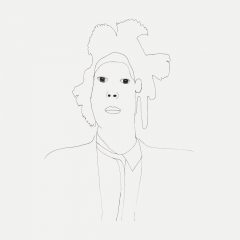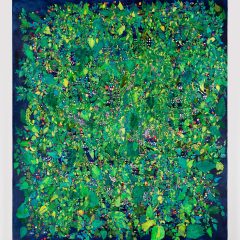[Chip explores and compares the wide range of abstract work being created by four artists, and comments on their treatment of space and human forms. — the Artblog editors]
Fleisher/Ollman‘s current show, Reprefantasion, which straddles yesteryear (2013) and the first month of 2014, also seeks to bridge the gaps between differing schools of abstraction. Four artists are represented in this group exhibition: Kate Abercrombie and Becky Suss, who distort the actual, and Kinke Kooi and Sarah Gamble, who decisively skip straight to the unreal. The show is on view through February 1.
Proclivity for pink: Kinke Kooi
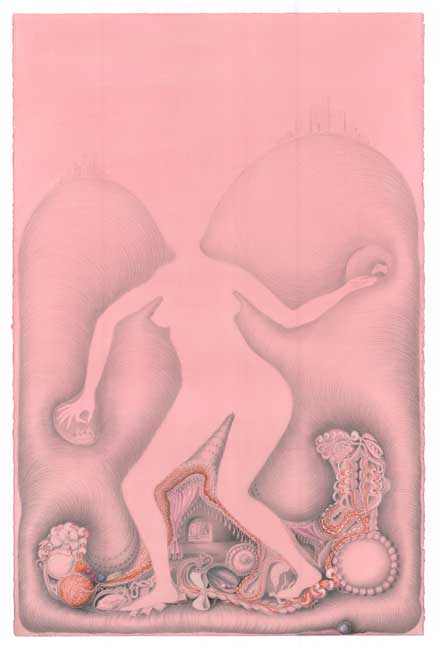
Most noticeable of Kinke Kooi’s work is that all of her pieces are rendered on paper in pinkish/orange hues, which provide a flesh-colored background to every image she creates. Her forms are overwhelmingly biological; although at times, they seem like something seen at the business end of a microscope lens, they’re more often than not bulbous and tangible enough to exist on our scale. Kooi’s macroscopic views are as much deep-sea as they are vulva, disconcertingly blurring the lines between mollusk and sex organ.
In “Matter,” smooth lumps of meaty substance lie lazily about a plane of penciled pink ground, connected by strands of similarly colored pearls. These interconnections are as much reminiscent of protein strands as they are of jewelry and gemstones–the imperceptibly delicate as well as the physically solid.
“Searching for Support” takes a figurative slant, as the negative space emerges into the shape of a standing woman. At her feet are a variety of reddish, unraveling balls and not-quite-helix shapes; her neck expands into a headless void. Amid these incomprehensible objects, the female figure’s head seems quite literally in the clouds, and she augments what power she has against the incongruities and mysteries of this bizarre journey we call life.
Colorful geometry: Kate Abercrombie
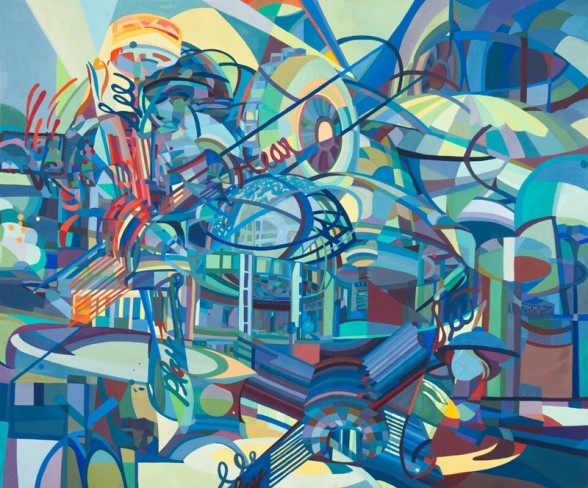
Kate Abercrombie presents a harsher, geometric, and considerably more colorful representation of the world in her paintings, which often evoke a busy urban world. One of her most intriguing pieces is “Unisphere,” in which blue-green crescents, domes, and blocks build upon each other and tumble away from reality in a confusing collapse of rigidity. Partly a smattering of architecture and signage, and partly pure pattern, these works offer a chaotic opposition to Kooi’s malleable manifestations.
A flat, familiar feeling: Becky Suss
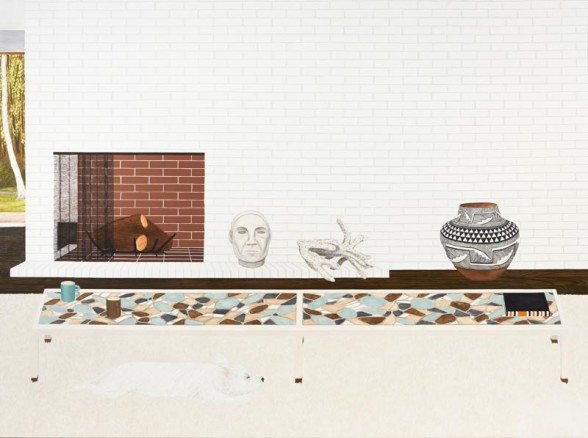
Somewhere between these two camps lie the works of Suss and Gamble. At first glance, Becky Suss appears to create relatively straightforward interiors, until one scrutinizes them a bit more intently. Her paintings are fairly easy to approach and maintain strong ties to the perceivable world, but in a flat, reductive way. Her interiors are sparse, clean, and spacious–more like memories than spaces in the three-dimensional world. Suss counters this feeling of detachment by constructing a number of ceramic pieces that reference, sometimes directly, the objects and artworks in her paintings, bringing these distant locales just a little bit more into our present moment…
Seeing through abstraction: Sarah Gamble
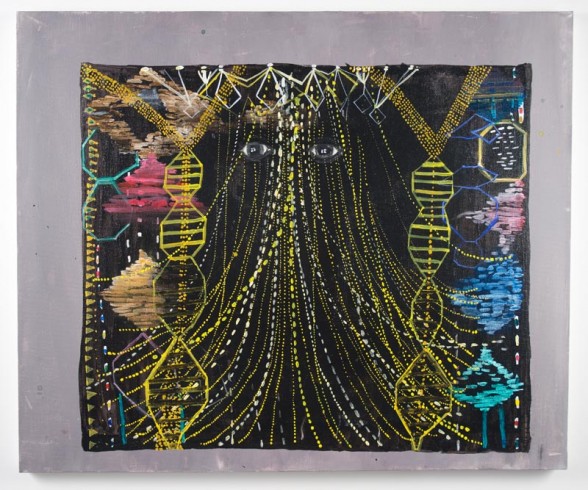
Sarah Gamble’s paintings often reflect the viewer–not in actuality, but through attentive characters hidden in her wily patterns. Amid the glow of lights, strings of orbs, wrapped DNA-like helix shapes, and the painter’s clearly visible paint strokes, eyes and faces peer back.
These unblinking sentries guarding otherwise dizzying displays prove to be silent and strong enough to instill the viewer with a sense of confidence not felt elsewhere in the exhibit. Their countenances are submerged in unreal forms, and the calm they possess is contagious. The unconscious mind is often capable of imagining faces and human figures in wood grain, stone, or other substances, but here, Gamble draws the associative lines for us.
With different converging means of abstraction, these four artists provide a range of views of both recognizably altered reality and the almost entirely immaterial. From Kooi’s biological blobs to Abercrombie’s hard angles, we are offered a range of representation both sharp and sensuous. Gamble takes us on a journey between the self and the other, while Suss solidifies our connections with memories and that which exists outside of us. Altogether, Reprefantasion is the sum of many parts, offering insight into varying schools of abstract thought and creation.





